Photo of BZE guests Ross Garnaut and Tony Windsor survey the solar field of one of Spain’s solar thermal power stations from the tower.
By David Rothfield
Until Beyond Zero Emissions’ (BZE’s) first research report in mid-2010, no-one had demonstrated that Australia could be powered reliably by 100% renewable energy with near zero emissions. Not even the Rudd government knew.
So the fossil fuel lobby’s claims that renewable energy couldn’t supply base-load power, that it was unaffordable, would cost jobs and wreck the economy was broadly accepted, even by some environmentalists.
July 2010 saw the launch of BZE’s Stationary Energy Plan. For over two years BZE researchers, in collaboration with Melbourne University’s Energy Research Institute, worked on the Plan, which convincingly demonstrated how a mix of technologies already commercially deployed elsewhere in the world, could power Australia reliably, exclusively from renewable sources.
Prior to its official launch, I became aware of this Plan and became an enthusiastic supporter. I undertook a BZE-run speaker-training course to learn about the Zero Carbon Australia project and join the cadre of BZE presenters delivering talks about their work.
BZE is a ‘climate solutions’ think tank whose goal is to transform Australia from a 19th century, fossil fuel-based, emissions intensive economy to a 21st century, renewable energy powered, clean tech economy. BZE volunteers and staff run research and public engagement programs.
The Zero Carbon Australia project is at the centre of the research program. The project, with its six constituent plans will provide a blueprint on how Australia can build a zero carbon economy and become a global leader in providing renewable energy solutions.
In 2010 the first of the plans, the Stationary Energy Plan was published. Since then we have given illustrated presentations to a diverse range of groups ranging from schools and universities to businesses, U3A classes, environmental groups, unions, politicians and so on. Our work has also featured on radio, TV and in the print media.
Whilst some of the technologies in the plan are familiar, such as wind turbines and rooftop PV panels, we introduce a relatively new technology – Concentrated Solar Thermal or CST – which can provide for 24-hour energy demand requirements, due to its energy storage capacity. So far Australia has only a few micro-CST systems.
The proposed CST system is based on plants already working in Spain and currently under construction in the USA. It is comprised of a large array of mirrors that track the sun’s movement across the sky. These mirrors reflect solar energy to a central point (the receiver) on a tower. The concentration of energy at that point results in temperatures of up to 600oC. A mix of molten salts can then be pumped through the receiver to take up and retain the heat. The molten salt mix is used because it remains in a liquid state over a wide range of temperatures. The hot liquid is stored in an insulated tank, acting like a giant thermos flask and can be released on demand, day or night, to drive steam turbines. Unlike in a coal-fired power plant, this system does not release CO2 and furthermore can be ramped up and down in an instant to meet demand.

Whilst our presentations are designed for the general public, we modify our talks to reflect specific audience profiles – and where necessary – include a discussion of the linkage between human-induced carbon emissions and climate change and their potentially disastrous consequences.
Early in 2013, the Australian Energy Market Operator published a long awaited report that confirms the feasibility of 100% renewable energy. We believe that all that is missing now is the political will to act.
Recently the second of our plans, the Zero Carbon Buildings Plan, was released which demonstrates how the implementation of a range of measures can halve domestic energy use. Whilst this proposition will be of particular interest to builders and architects, the Buildings Plan also has much useful information for homeowners doing renovations.
The Buildings Plan gives several reasons why we need to phase out gas and move to fully electric operation of all domestic devices. The changing nature of gas extraction and processing is creating greatly increased emissions levels, a fact being concealed by the gas companies and overlooked by the government. Furthermore, as Australian gas is sold into the international gas market, substantial price increases are inevitable here.
Other BZE Plans due for release during 2014 include the Transport and Land Use Plans. The Transport Plan will demonstrate how the entire land transport system can become emissions free through electrification. The plan includes a thoroughly researched high-speed rail proposal that makes a significantly stronger case for its implementation than does the government-sponsored proposal.
While BZE has demonstrated the existence of great opportunities for Australia to leverage its natural advantage in solar and wind resources, the prevailing conservative political wisdom continues to favour the exploitation of Australia’s massive reserves of fossil (carbon polluting) resources.
Meanwhile overseas economies are increasing their investment in renewables on which our future depends. BZE is showing how we can create a zero-emissions economy and build a safe climate future for our children. But we are running out of time.
You can find out more about Beyond Zero Emissions at: www.bze.org.au.
Presenting Climate Solutions

